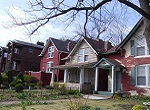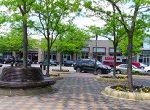Community Attachment Research Provides Excellent Discussion Points
Last Updated: June 20, 2024
Some recent community attachment research is proving that our instincts about what
actually builds loyalty to your particular city is right on target. It may be that some of the work that neighborhood associations and community development corporations have been doing may be misdirected. Let's explore this interesting opportunity to do community work more effectively.

Economic development and community development professionals, elected officials, and engaged citizens need to take a fresh look at how their community stacks up on the factors that keep residents loyal to your particular place.
You might believe it doesn't matter too much whether or not people form an emotional bond to the community, in a mobile society such as the U.S. or a planned economy such as China.
However, when you consider the degree to which technology allows
more and more people to work anywhere, it really does matter whether
your residents are emotionally involved with the community and also whether they invest their time, energy, and money in your community's betterment.
As those involved in economic development frequently observe, keeping your most talented young people in your community, or in the city where they attend college, can be very important to economic development success, as well as creative richness.
But surprisingly, the factors related to community attachment stay relatively constant from one age group to another; only the emphasis differs.
Back in the first decade of the 21st century, the Knight Foundation teamed up with a leading research organization, Gallup, to study what makes people want to stay in the community and how sad they would feel if they had to leave.
The study, known as the Soul of the Community Survey, took place over a three year period in 26 U.S. cities where Knight owns newspapers. To be sure, that may skew the results in ways we can't know; the cities aren't evenly distributed over the country.
But since this aligns well with the intuition and experience of the editors of this website, at the time we thought the results were worth paying attention to. We still think that, which is why we are going to describe those results before describing the 2018-2019 update, called Community Ties, which was published jointly by the Knight Foundation and the Urban Institute. The resulting 2020 publication is targeted more specifically toward factors that the community can actually change, and we find it to be considerably more general and vague, but at the same time a little less nerdy and more readable.
Why People Love Their Communities and Want to Stay
We begin with the original study's findings.
So, drum roll, please: the highest correlation among the characteristics studied with community attachment is social offerings! This was true in every single American city, whether large or medium size. Social offerings were defined to people answering the survey as vibrant nightlife, availability of the arts and culture, social community events, places to meet each other, and the feeling that people in the community care.
Next most important was what the researchers called openness. The researchers on community attachment defined openness as the community being welcoming and seen as good for older people, minorities, families with young children, the talented college graduates looking for work, immigrants, the LGBTQ community, and young adults without children.
Another surprise to some is that aesthetics rounds out the top three reasons people are attached to their particular city and would hate to leave. This was defined to mean the physical beauty of the place and the availability of parks and open space.
How to Take Advantage of the Community Attachment Data
Looking at this from the standpoint of how to give you folks good advice, we decided that you are able to influence all of these characteristics significantly.
You can influence nightlife and places for people to meet, such as coffee houses and lower-cost restaurants, through good old-fashioned entrepreneurship support. You may want to investigate the possibility of a night mayor if you feel that the safety or vibrancy of your nightlife needs greater attention.
Places for people to meet of course can be public places too, such as the library and schools. Your "third places," which is a buzz word for somewhere that is not home and not work, certainly can and should include community organizations, places of worship, recreation centers or gyms or spas, and the outdoors.
In small towns, you might need to make sure the third places are adequately supported. If the church buildings routinely aren't opened up for other community functions, talk to their leaders about how they could contribute to this good work.
You can influence community openness to diversity only through working with citizen attitudes and experience base.
Begin by examining how racial equity and community development intersect. If your community is suffering from racial inequity (and which American community isn't?), then you need a serious program of exposing the majority community and the privileged community to the experience of those who do not share that privilege. Serious work at dialogue and simply telling stories will be needed in your community. You can't be seen as a welcoming community if only some folks are made to feel welcome, while other folks are viewed with suspicion just for walking, driving, sitting on a park bench, going into a store, or daring to try to vote.
Tolerance is important for a whole variety of reasons. For example, we are beginning to understand the relationship of bullying and allowing kids to be taunted to crime prevention and teen suicide prevention.
In addition to working with moderate religious leaders, who are
available to almost every community, there are several good programs and
organizations that can help in this area. We'll mention A World of Difference anti-bias education program if you think you need some help in this area. Everyday Democracy also sponsors many good projects about racism and other hindrances to a truly diverse society.
There are many others, including anti-bullying programs.
Note that improving openness is a free or low-cost proposition, although attitude change is really hard work. You may think this is far afield for a community development website, but given that the loyalty to your community is at stake, we think this goes right to the heart of the issue. Bright young adults especially are fed up with all kinds of prejudice. If you want to keep your children in town, take this to heart.
The third category, community beauty, is intriguing because natural beauty is beyond your control, but good urban design, man-made beauty, and whether or not you preserve your scenic vistas is subject to policy decisions.
There are exceptions. Some of you might be able to take down some obnoxious billboard that's blocking your view of the most beautiful sunset anywhere.
Some of you may need to restore forests that used to surround the town, or take better care of the urban forest. Even in the completely built-out sections of your community, emphasize the maintenance of your tree canopy; our page by that name has some great information for you.
Natural disasters may devastate your natural beauty for a time. But by and large, you simply need to take good care of it. Some of you have mountains, the ocean, pure lakes, clean skies, and red rock, and some of you don’t.
But everywhere the beauty or ugliness of the built environment is reflected in the degree of community attachment. That's why it's essential to get urban design principles into the discussion if you want to raise the community attachment level, keeping your talented young workforce around. You can work hard to preserve or even create neighborhood character. If you are in a small, essentially rural community, see our page about small town character for inspiration.
The other major element of beauty that you can control is your parks and open space. You can gradually find spaces for new parks, or preserve the open space that's already available at the edge of town through preventing urban sprawl.
Many communities feel threatened by a lack of funding for park maintenance, but this research shows the impact of parks on customer satisfaction in the form of community loyalty.
Clean-up events of all types are good ways to improve the aesthetics of town without costing too much money. In keeping with the open space theme, you could start with cleaning up your neighborhood park.
Community Attachment by the Numbers
For those of you who would like to see the numbers, below are the correlations between community attachment and the various community attributes that were studied in the first report.
To read this, understand that research studies often show a correlation between two characteristics. A perfect correlation would be 1.0. This means, for example, that everyone with a Yes answer on question 1 has a No answer on question 2. So a 1.0 correlation would be very rare indeed. Indeed, anything more than 0.2 or so is considered important and worth paying attention to, depending on the person doing the evaluation and the subject matter.
Below we grouped them into high, medium, and low, although only the lowest one (civic involvement) is so low as to be possibly due to research design or errors in the study.
The factors with the highest relationship to community loyalty included:
- Social offerings (.54)
- Openness (.50)
- Aesthetics (.49)
- Education (.47)
Isn't that interesting if you are a member of a city council or a mayor? Are these the things you spend your time on? With the exception of maybe trying to wipe out some negative aesthetic factors, probably these are not your focus.
These items show medium correlation to emotional attachment to the community:
- Basic services (.42)
- Leadership (.39)
- Economy(.36)
The lowest relationships to bonding with a community are:
- Safety (.23)
- Social capital (.15)
- Civic involvement (.04)
I can hear you saying "what?" in some places with high crime right now. But this finding held true just about regardless of where people were. Just hold on though, because the second study showed safe places to live and work to be an important determinant of emotional attachment and investment in the community.
In the original study, demographics, which means population characteristics, didn't appear to drive how much people loved their communities. Attachment did increase a bit as income and age were higher. Our speculation is that this is due to greater access to cultural amenities and safe recreation and work places, as highlighted by the second study.
In another interesting lesson for leaders, the original study showed that the most attached people were those who had lived in the community between three and five years, but the least bonded are those who have lived there two years or less.
This suggests that you need to engage newcomers quickly, keep them involved in something for the first three years, and then they really will be your boosters and your volunteers.
Those of you who need to build population should really take note of this factor, and build some kind of a fun monthly dinner or picnic club for newcomers with an eligibility span of almost three years before people are launched out into a variety of other community activities.
You can see what the Knight Foundation continues to "own" on its website in its Soul of the Community section.
Now let's highlight the key findings of the second, more recent, more leadership-oriented study, called Community Ties. This one defined community attachment more broadly in a way, including both what they called sentiment (the emotional attachment we have been describing up until now) and action (actual moving behavior and investment of time, energy, and resources into the community).
In Community Ties, major findings included the following:
The more time a person spent in the main city of the metro area, the more attached that person was, especially in terms of actions.
Quality of life measures, including the top-ranking factor of housing quality and affordability, accounted for about a third of moves to a metro area and a third of the decision to stay. Quality of life was also an important emotional factor in attachment, as we might imagine.
Those with more access to arts and culture were more attached, both in terms of sentiment and action. Note that access might entail everything from the existence of cultural activities to convenient transportation to reach them to the economic means to participate.
Easy access to recreation and to safe places to work and play resulted in more community attachment, especially in terms of sentiment.
In this second study, age, race, and income did change the findings. As we would expect, younger people were more interested in nightlife and also had more bridging capital, which is the Urban Institute jargon for relationships across racial and economic lines. Older people expressed more satisfaction with their cities and less wanderlust for moving. And those in midlife invested the most time and resources into their cities. Minorities expressed less access to arts and culture, although they valued these things highly.
The full Community Ties report on attachment may be studied or downloaded, and from the same page you can download data to compile your own statistics of interest.
In sum, you can see that the research so far leads to varied conclusions, and we hope that future research can be undertaken in different cities, using somewhat more fine-grained definitions and indicators than either of the previous studies. But we think the findings are provocative enough to be well worth discussing in your own communities.
One interesting result of the original posting of this article is that someone asked a follow-up question about neighborhood attachment. That caused us to speculate about how neighborhood attachment might be different. Check it out if you work at the neighborhood scale.
For Related Reading on Community Social Offerings and Community Beauty
- Making and Keeping a Good Community >
- Community Challenges, Common Topics & Concepts >
- Economic Development > Community Attachment
Join GOOD COMMUNITY PLUS, which provides you monthly with short features or tips about timely topics for neighborhoods, towns and cities, community organizations, and rural or small town environments. Unsubscribe any time. Give it a try.




